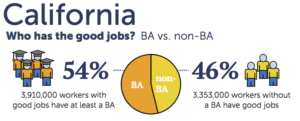
I’ve just come across some research from The Georgetown University Center on Education and the Workforce (CEW) that is truly eye opening and has challenged my way of thinking about education.
I’ve mentioned before that I earned my degree from Claremont McKenna College and I’m pleased that my three children attended and completed college. This push for a college education was ingrained in me from an early age.
I was raised by parents who believed that the only path to success was a college education. Mom and dad had degrees, and they were going to make darn sure that my four sisters and myself earned degrees. To help us reach that goal, my parents started a college fund for all of us when we were young.
In addition to the college fund, any conversation about our future always focused on a four-year degree. My dad would never even allow a discussion of a two-year degree or attending a community college and then transferring to a university.
Early on, my dad made it clear to me that I was to attend college, get a degree and then go to work. He once told me, “You will go to college. If you choose not to go to college, do not come home and you had better have a job and be able to support yourself.”
The day after I graduated with my degree, my dad handed me a check for $2,500 to buy three suits and to put a deposit down on an apartment. That was it. There was no invitation to return home. With a background like this, you can imagine my surprise when I discovered the Good Jobs Project, a research project by CEW and JPMorgan Chase.
The Good Jobs Project
In my mind, a college degree was the best path to a successful career. With the changes in today’s workplace and college tuition rates, is it possible for a young person to find a “good job” without a college degree? To find an answer to this question, I took a look at the research from the Good Jobs Project.
One of the first things the researchers had to do was define the term, “Good Job.” They determined that a good job pays an average $65,000 for workers with a bachelor’s degree (BA) or higher, $55,000 for workers with less than a bachelor’s degree or an occupation that pays at least $35,000 a year.
Based on this information, if you have less than a BA and are paid between $17 and $27 an hour, you have a “Good Job.” And, based on my discussions with employers in our association, I think you’ll find that most skilled jobs in the printing and graphics industry here in Southern California meet the criteria for a “Good Job.”
The researchers went on to explain that since 1991, employment opportunities for individuals with only a high school education have declined. During that same time, employment opportunities for those with a BA or higher have increased. The researchers also found that there was another area where employment opportunities have grown.
Workers with more education than a high school diploma, but less than a BA including, certificates, certifications, licenses, associate’s degrees, and some college coursework have seen their job opportunities increase. According to the report, there’s a significant transformation from traditional blue-collar jobs to more skilled technical positions. I think this holds true in our industry.
When the recession hit in 2009, the printing industry underwent an enormous change. This change was as much technical as it was economic. Due to the downturn, companies lost clients, revenue, and employees. At the same time, the industry saw an enormous increase in technically advanced equipment. Many of the jobs that were available before the recession no longer exist. And the skill level needed from potential employees today is much higher than from employees of the past. This change has been going on for years, and it’s even more pronounced today.
A “Good Job” in California
Between 1991 and 2015 California lost 232,000 blue-collar non-BA good jobs, but gained 265,000 skilled-services good jobs for workers without BAs. In 2015, the majority (56%) of non-BA California workers with “Good Jobs,” earned $55,000 or higher.
Important Questions to Ask
In previous blogs, I’ve discussed the dismal high school and college dropout rates. We know that of all U.S. high school students who graduate and go on to college, a large proportion will never earn their degree. Nearly 40 percent of those who go to four-year colleges and some 70 percent of students at a community college will never earn their degree.
Based on this information and the CEW research, perhaps students, parents, and educators should be asking:
- What does a four-year degree really mean?
- What truly marketable skills can new graduates offer the workforce?
- Is a college degree essential to acquire gainful employment?
- Will a degree lead to a “Good Job?”
The researchers at the Good Jobs Project recommended, “Policymakers should promote transparency and accountability by ensuring that students and their families are provided information about the value they will get for their investment, particularly the employment and earning outcomes of different education and training programs.”
Let talk about employment and earning outcomes within our industry. The global print industry is estimated to be eight times bigger than the video game industry and even rivals the auto industry. The industry is forecast to reach $814.5 billion in 2022, driven by growth in packaging and labels.
Due to the industry’s aging labor force, many “Good Jobs” are available now and will be for years to come. These jobs, like many of those mentioned in the CEW report, are shifting from traditional blue-collar to skilled-technical jobs.
College degrees and increasing student debt
In this discussion, we have not even mentioned the mounting problem of student debt. The average student loan debt for the Class of 2017 graduates was $39,400. College graduates will spend years paying back those loans. Consider that 44.2 million Americans have $1.48 trillion in total U.S. student loan debt and you have to ask yourself; is there a better way?
It seems that without all that student loan debt, individuals who complete sub-baccalaureate degrees or certificates that are aligned with the labor market can get a financial head start in life.
Good Jobs Require More Education
In today’s world, young people, their parents, and their school counselors need to understand that, as my father said, college is necessary for a successful career. But, much to my father’s chagrin, today’s youth have a college path that is wide and varied. That path could be certification through a community college or a BA program at a university. Each of these has advantages and disadvantages.
A certificate may allow a young person to get a Good Job in the industry and do so without a lot of student debt. On the other hand, will the lack of a degree hamper advancement opportunities later in their career? A BA will allow a young person to get a Good Job but this may come with the extra burden of student debt. And, not all BAs are equal. Studies show that, over their lifetime, a person with a BA will earn more than a high-school graduate, yet if the degree is not aligned with the labor market, their lifetime earnings can be reduced.
Where to Find a Good Job
With substantial growth in middle-skills “Good Jobs” the question is, “Where can a young person go to acquire these skills?” Individuals looking for “Good Jobs” in the printing and graphics industry can turn to local educational institutions for help. A few months ago I wrote about some of the colleges and universities in Southern California that provide training and re-training for our industry. These schools can provide six-month certificates, two-year certifications, associate, transfer, and BA degrees.
Whether you have your certificate, degree or already have experience, you can look to the Printing Industries Association, Inc. of Southern California (PIASC) for help. Our Employment Services department is staffed with experienced recruiters that match employees with employers. These recruiters work with PIASC member companies to find employees a “Good Job” in the industry. This can be anything from temporary work during summer or winter break during school to full-time work upon completion of a certificate or a degree.
The PIASC recruiters will review your resume, conduct an interview to discuss your skills and abilities, and then match you with companies who are looking for your specific skills. As of publication date, the PIASC Employment Services department has over 100 jobs available. These include CSRs, press operators, accountants, and even a CEO.
The truth is, there’s more than one path to a “Good Job.” And there are educational institutions right here in Southern California that can help young people find a path to a successful career in the printing and graphics industry.


